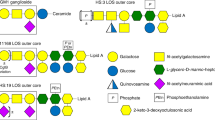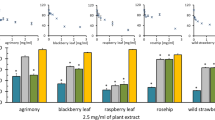Abstract
The capacity of cholera toxin (CT) and type I heat-labile enterotoxin produced by Escherichia coli isolated from human intestine (LTh) to interact with glycoconjugates bearing ABH blood group determinants from rabbit intestinal brush border membranes (BBM) was studied. On the basis of the type of intestinal compounds related to the human ABH blood group antigens, rabbits were classified as AB or H. Toxin binding to the intestinal glycolipids and glycoproteins depends on the blood group determinant borne by the glycoconjugate and on the analyzed toxin. LTh was capable of interacting preferentially with several blood group A- and B-active BBM glycolipids compared to those isolated from animals lacking these antigens (H rabbits). Also, LTh preferably bound to several BBM glycoproteins from AB rabbit intestines compared to those from H ones. One of these glycoproteins, the sucrase-isomaltase complex (EC 3.2.1.48-10) isolated from AB and H rabbits showed the same differential LTh binding. Conversely, CT practically did not recognize either blood group A-, B-, or H-active glycolipids and glycoproteins. These results may be relevant for carrying out in vivo experiments in rabbits in order to disclose the role of ABH active-glycoconjugates in the secretory response induced by LTh in rabbit intestine.
Similar content being viewed by others
References
Finkelstein RA, Burks MF, Zupan A, Dallas WS, Jacob CO, Ludwig DS: Epitopes of the cholera family of enterotoxins. Rev Infect Dis 9: 544–561, 1987
Moss J, Vaughan M: Mechanism of action of choleragen and E. coli heat-labile enterotoxin: Activation of adenylate cyclase by ADP-ribosylation. Mol Cell Biochem 37: 75–90, 1981
Fishman PH: Mechanism of action of cholera toxin. In: J. Moss and M. Vaughan (eds). ADP-ribosylating toxins and G proteins: Insights into signal transduction. Am Soc Microbiol, Washington DC, 1990 pp 127–140
Holmgren J, Lindblad M, Fredman P, Svennerholm L, Myrvold H: Comparison of receptors for cholera and Escherichia coli enterotoxins in human intestine. Gastroenterology 89: 27–35, 1985
Griffiths SL, Crithley DR: Characterization of the binding sites for Escherichia coli heat-labile toxin type I in intestinal brush borders. Biochim Biophys Acta 1075: 154–161, 1991
Barra JL, Monferran CG, Balanzino LE, Cumar FA: Escherichia coli heat-labile enterotoxin preferentially interacts with blood group A-active glycolipids from pig intestinal mucosa and A-and B-active glycolipids from human red cells compared to H-active glycolipids. Mol Cell Biochem 115: 63–70, 1992
Balanzino LE, Barra JL, Monferran CG, Cumar FA: Differential interaction of Escherichia coli heat-labile toxin and cholera toxin with pig intestinal brush border glycoproteins depending on their ABH and related blood group antigenic determinants. Infect Immun 62: 1460–1464, 1994
Teneberg S, Hirst TR, Angström J, Karlsson K-A: Comparison of the glycolipid-binding specificities of cholera toxin and porcine Escherichia coli heat-labile enterotoxin: Identification of a receptor-active non-ganglioside glycolipid for the heat-labile toxin in infant rabbit small intestine. Glycoconjugate J ll: 533–540, 1994
Holmgren J, Fredman P, Lindbland M, Svennerholm AM, Svennerholm L: Rabbit intestinal glycoprotein receptor for Escherichia coli heat-labile enterotoxin lacking affinity for cholera toxin. Infect Immun 38: 424–433, 1982
Zemelman BV, Chu SHW, Walker WA: Host response to Escherichia coli heat-labile enterotoxin via two microvillus membrane receptors in the rat intestine. Infect Immun 57: 2947–2952, 1989
Bennun FR, Roth GA, Monferran CG, Cumar FA: Binding of cholera toxin to pig intestinal mucosa glycosphingolipids: Relationship with the ABO blood group system. Infect Immun 57: 969–974, 1989
Monferran CG, Roth GA, Cumar FA: Inhibition of cholera toxin binding to membrane receptors by pig gastric mucin-derived glycopeptides: Differential effect depending on the ABO blood group antigenic determinants. Infect Immun 58: 3966–3972, 1990
De SN: Enterotoxicity of bacteria free culture filtrate of Vibrio cholerae. Nature 183: 1533–1534, 1959
Kelly JJ, Alpers DH: Blood group antigenicity of purified human intestinal disaccharidases. J Biol Chem 248: 8216–8221, 1973
Gorvel JP, Wisner-Provost A, Maroux S: Identification of glycoproteins bearing human blood group A determinants in rabbit enterocyte plasma membranes. FEBS Lett 143: 17–20, 1982
Dallas WS: Conformity between heat labile toxins genes from human and porcine enterotoxigenic Escherichia coli. Infect Immun 40: 647–652, 1983
Clements JD, Finkelstein RA: Isolation and characterization of homogeneous heat-labile enterotoxins with high specific activity from Escherichia coli cultures. Infect Immun 24: 760–769, 1979
Panzetta P, Gravotta D, Maccioni HFJ: Biosynthesis and expression of gangliosides during differentiation of chick embryo retina cells in vitro. J Neurochem 49: 1763–1771, 1987
Magnani JL, Smith DF, Ginsburg V: Detection of gangliosides that bind cholera toxin: Direct binding of 125I-labeled toxin to thin-layer chromatograms. Anal Biochem 109: 399–402, 1980
Hauser H, Howell K, Dawson RMC, Bowyer DE: Rabbit small intestinal brush border membrane. Preparation and lipid composition. Biochim Biophys Acta 602: 567–577, 1980
Bradford M: A rapid and sensitive method for the quantitation of microgram quantities of protein utilizing the principle of protein-dye binding. Anal Biochem 72: 249–254, 1976
Dahlqvist A: Method for the assay of intestinal disaccharidases. Anal Biochem 7: 18–25, 1964
Sjöstrom H, Norén O, Jeppsen L, Staun M, Svensson B, Christiansen L: Purification of different amphiphilic forms of a microvillus aminopeptidase from pig small intestine using immunoadsorbent chromatography. Eur J Biochem 88: 503–511, 1978
Laemmli UK: Cleavage of structural proteins during the assembly of the head of bacteriophage T4. Nature 227: 680–685, 1970
Towbin H, Staehelin T, Gordon J: Electrophoretic transfer of proteins from polyacrylamide gels to nitrocellulose sheets: Procedure and some applications. Proc Natl Acad Sci USA 76: 4350–4354, 1979
Mollicone R, Cailleau A, Imberty A, Gane P, Perez S, Oriol R: Recognition of the blood group H type 2 trisaccharide epitope by 28 monoclonal antibodies and three lectins. Glycoconjugate J 13: 263–271, 1996
Teneberg S, Angström J, Jovall P-A, Karlsson K-A: Characterization of binding of Galβ4GlcNAc-specific lectins from Erythrina cristagalli and Erythrina corallodendron to glycosphingolipids. Detection, isolation, and characterization of a novel glycosphingolipid of bovine buttermilk. J Biol Chem 269: 8554–8563, 1994
Kolinska J, Semenza G: Studies on intestinal sucrase and on intestinal sugar transport. V. Isolation and properties of sucrase-isomaltase from rabbit small intestine. Biochim Biophys Acta 146: 181–195, 1967
Barua D, Paguio AS: ABO blood groups and cholera. Ann Hum Biol 4: 489–492, 1977
Chaudhuri AS, De S: Cholera and blood-groups. Lancet ii: 404, 1977
Levine MM, Nalin DR, Rennels MB, Hornick RB, Sotman S, van Blerk G, Hughes TP, O'Donell S: Genetic susceptibility to cholera. Ann Hum Biol 6: 369–374, 1979
Glass RI, Holmgren J, Haley CE, Khan MR, Svennerholm A-M, Stoll BJ, Belayet Hossain KM, Black RE, Yunus M, Barua D: Predisposition for cholera of individuals with O blood group. Am J Epidemiol 121: 791–796, 1985
Clemens JD, Sack DA, Harris JR, Chakraborty J, Khan MR, Huda S, Ahmed F, Gomes J, Rao MR, Svennerholm A-M, Holmgren J: ABO blood groups and cholera: new observations on specificity of risk and modification of vaccine efficacy. J Infect Dis 159: 770–773, 1989
Black RE, Levine MM, Clements ML, Hughes T, O'Donnell S: Association between O blood group and occurrence and severity of diarrhoea due to Escherichia coli. Trans R Soc Trop Med Hyg 81: 120–123, 1981
Karlsson K-A: Microbial recognition of target-cell glycoconjugates. Curr Opin Struct Biol 5: 622–635, 1995
Miller-Podraza H, Stenhagen G, Larsson T, Andersson C, Karlsson K-A: Screening for the presence of polyglycosylceramides in various tissues: Partial characterization of blood group-active complex glycosphingolipids of rabbit and dog small intestines. Glycoconjugate J 14: 231–239, 1997
McKibbin J: Fucolipids. J Lipid Res 19: 131–147, 1978
Björk S, Breimer ME, Hansson GC, Karlsson K-A, Leffler H: Structures of blood group glycosphingolipids of human small intestine. A relation between the expression of fucolipids of epithelial cells and the ABO, Le and Se phenotype of the donor. J Biol Chem 262: 6758–6765, 1987
Finne J, Breimer ME, Hansson GC, Karlsson K-A, Leffler H, Wegenhart JFG, van Halbeek H: Novel polyfucosylated N-linked glycopeptides with blood group A, H, X and Y determinants from human small intestinal epithelial cells. J Biol Chem 264: 5720–5735, 1989
Orlandi PA, Critchley DR, Fishman PH: The heat-labile enterotoxin of Escherichia coli binds to polylactosaminoglycan-containing receptors in CaCo-2 human intestinal epithelial cells. Biochemistry 33: 12886–12895, 1994
Author information
Authors and Affiliations
Rights and permissions
About this article
Cite this article
Balanzino, L.E., Barra, J.L., Galváin, E.M. et al. Interaction of cholera toxin and Escherichia coli heat-labile enterotoxin with glycoconjugates from rabbit intestinal brush border membranes: Relationship with ABH blood group determinants. Mol Cell Biochem 194, 53–62 (1999). https://doi.org/10.1023/A:1006971913175
Issue Date:
DOI: https://doi.org/10.1023/A:1006971913175




